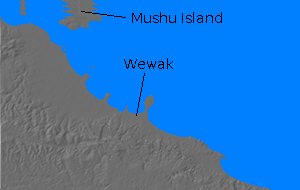![]() The Pacific War Online Encyclopedia
The Pacific War Online Encyclopedia
|
| Previous: Wenneker, Paul W. | Table of Contents | Next: Weyler, George L. |
 |
U.S. Army. Via Wikipedia Commons |
In 1941, Wewak (143.645E
3.573S) was a good but almost completely undeveloped
harbor on the north coast of New
Guinea. It was the seat of the Sepik district of the Mandated
Territory of New Guinea. It is located on a narrow coastal plain, with
the Toricelli Mountains just
inland of the coast. This plain is crossed by numerous rivers and
streams prone to flash flooding. The Old German Road followed the coastline
but was little more than a trail.
Japanese
forces
landed here on 1 January
1943 and built
up a sizeable air base
complex. By March 1943, most of 41 Division had joined the garrison.
During the week of 16-23 August 1943, the American 5 Air Force pounded Wewak into uselessness after a clever deception operation drew Japanese attention away from a new fighter strip at Tsili Tsili. Kenney had ordered a large dummy strip constructed at Bena Bena, a few miles from Tsili Tsili, and the Japanese did not discover the deception until 14 August. By then the Americans had assembled a large fighter force at Tsili Tsili.
On 10 August the Japanese had massed over 250 aircraft at Wewak for an air counteroffensive. These began raiding Tsili Tsili almost as soon as it was discovered. However, on 17 August, as the Japanese were preparing to launch a massive strike against the new Allied airfield, some 48 heavy bombers, 31 B-25 strafers, and 85 P-38 Lightning fighters from Tsili Tsili surprised the Japanese and destroyed 70 aircraft on the ground. A second strike the next day destroyed many more Japanese aircraft. These operations broke the back of Japanese air power in central New Guinea.
The rugged terrain
made Wewak an unappealing target for direct assault, as did the large
number of Japanese defenders. It was therefore bypassed by the Aitape and Hollandia landings in April 1944.
The Australian 6 Division
(Stevens) advanced eastwards
toward Wewak in early 1945, a controversial action considering the
Japanese at Wewak were isolated and struggling simply to feed
themselves. Wewak itself fell on 11 May 1945, forcing the remnants of 18 Army into the trackless
wastes of the New Guinea interior, where most starved.
Reference
The Pacific War Online Encyclopedia © 2007-2008, 2010, 2013 by Kent G. Budge. Index